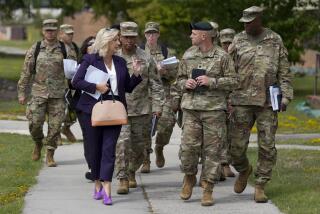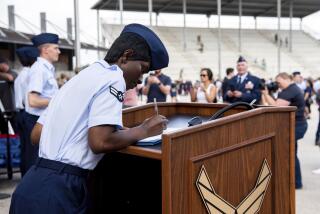Army Says It Has Enough Troops for 3 More Years
WASHINGTON — The Army’s top general on Tuesday vigorously opposed calls for expanding his branch of the military, saying the current force of roughly 500,000 is big enough to fight wars in Afghanistan and Iraq for at least the next three years.
At a time when the Army has doubled the length of deployments, temporarily prevented thousands of soldiers from leaving the service and called up more than 100,000 reservists, Gen. Peter J. Schoomaker, the Army chief of staff, acknowledged that the war in Iraq was “stressing” the Army. “I don’t think that’s a secret,” he said at a breakfast with reporters.
But Schoomaker predicted that the need for additional troops would be temporary and said that permanently increasing the Army’s size would bleed money from programs to improve the equipment soldiers need to fight successfully.
Schoomaker said the June 30 transfer of sovereignty to Iraqis would not shift the military’s focus from defeating insurgents and stabilizing the country.
Schoomaker came out of retirement last August to replace Gen. Eric K. Shinseki, who said that far more troops would be needed to fight in Iraq than the Pentagon ended up sending. This year, at Schoomaker’s request, Defense Secretary Donald H. Rumsfeld invoked emergency powers authorizing the Army to temporarily add 30,000 troops to its congressionally mandated force of 482,000.
To date, the Army has added about 13,000 of the extra troops by redoubling recruiting efforts and introducing a variety of bonuses and mandates to retain troops nearing the end of their enlistment.
There are at least three initiatives in Congress that could make that increase permanent. But Schoomaker said that over the long term, he hoped to eliminate the need for the extra troops by making the Army more efficient. By increasing the proportion of combat troops and farming out support jobs to civilians, “we can sustain the current level of effort indefinitely,” Schoomaker said.
That premise is controversial. With some commanders in Iraq complaining publicly that they need more soldiers, lawmakers have been exerting pressure for troop increases. Those calls were intensified by the Army’s announcement this month that it will prevent soldiers whose units have been tapped for Iraq duty from leaving the service, even if they are due to be discharged.
The House last month approved a $447-billion defense bill for fiscal 2005 that includes a provision by Rep. Duncan Hunter (R-El Cajon), chairman of the House Armed Services Committee, to expand U.S. forces by 39,000 by 2007.
The Senate, in its debate on the bill, is considering language from the Armed Services Committee that would allow an increase of 30,000 by 2009.
Sen. Jack Reed (D-R.I.) said he planned to introduce an amendment to that bill that would permanently add 20,000 troops. And Massachusetts Sen. John F. Kerry, the presumptive Democratic presidential nominee, has called for a permanent increase of 30,000 troops.
One argument against expansion is that troops are getting increasingly expensive. The Congressional Budget Office has estimated that adding about 10,000 troops costs $1 billion annually. The Army has said that adding 30,000 troops would eventually add $3.6 billion to its budget -- not counting training, operating and equipment costs.
Military personnel costs have grown 30% between fiscal 2000 and 2005, the nonpartisan Congressional Research Service said in a report released Thursday.
Personnel accounts for more than half of the Army’s budget. Once an increase in the ranks is voted into law, the cost of those new soldiers’ pensions and benefits remains a permanent obligation.
“Congress can only fund us one year at a time,” Schoomaker said. “They can encumber us forever. We are very reluctant to be encumbered by more [personnel] than is necessary.”
He said the Army had another solution in mind: remaking itself by creating as many as 15 additional active-duty combat brigades. They would be smaller than today’s combat units and would employ technology, speed and increased efficiency to add power, he said.
Acknowledging that the pace of the last three years has been rough on Army families, Schoomaker said the changes to the Army’s structure were designed to limit deployments to one year in any three-year period for active-duty soldiers and one year for every five to six years of service among reservists.
Addressing the future mission of the Army, Schoomaker said religious and ethnic extremism posed a long-term threat that could involve weapons of mass destruction. “I can’t remember a time that, honestly, was more dangerous than what we’re in today because of the nature of this threat,” he said.
The U.S. plans to keep at least 138,000 troops in Iraq through 2005. A plan to cut the force to between 105,000 and 115,000 as political power is turned over to an interim Iraqi government was discarded in the face of the continuing insurgency.
Schoomaker said that if the war on terrorism and the war in Iraq continued to strain the military, his plan to remake the Army could hit snags.
“If we get to a point in 2007 that says I can’t make the efficiencies, I’m going to say we need a permanent” increase in manpower, he said.
More to Read
Sign up for Essential California
The most important California stories and recommendations in your inbox every morning.
You may occasionally receive promotional content from the Los Angeles Times.










